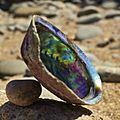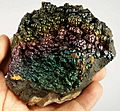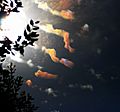Iridescence facts for kids

Iridescence is a special way some surfaces show color. Their color seems to shift and change as you look at them from different angles. It also changes depending on how light shines on them. Think of a soap bubble or a butterfly wing. They sparkle with many colors, and these colors move as you tilt them.
You can find iridescence all around you in nature. It's in soap bubbles, the shiny wings of butterflies, and the inside of some sea shells. Certain minerals also show this effect. These amazing colors are not from dyes or pigments. Instead, they are structural colors. This means tiny structures on the surface play with light.
Contents
How Does Iridescence Work?
The main reason iridescence happens is something called interference. Imagine light as tiny waves. When these light waves hit a surface with very small, repeating patterns, they can bounce off in a special way. Some waves might bounce off the very top layer, while others go a little deeper and bounce off a layer below.
When these waves come back out, they can either join up and become stronger (making a bright color) or cancel each other out (making that color disappear). Which colors you see depends on the exact thickness of the layers and the angle of the light. This is why the colors seem to change as you move or as the light changes.
Where Can We See Iridescence?
Iridescence is common in many places, both natural and man-made.
In Nature
Many animals and plants use iridescence.
- Insects: The wings of many butterflies and flies shimmer with iridescent colors. This can help them attract mates or even scare off predators.
- Birds: The feathers of a peacock are famous for their stunning iridescent blues and greens. The Nicobar pigeon also has beautiful iridescent feathers.
- Fish and Reptiles: Some fish, like the catfish, and reptiles, like the rainbow boa, have scales that show iridescence.
- Plants: Certain plants, like some types of Begonia, have iridescent leaves. This might help them capture light in dim places.
- Minerals: You can see iridescence in some bismuth crystals and labradorite stones. Even Goethite, an iron mineral, can be iridescent.
- Other examples: You might notice iridescence on a thin film of fuel on water, or even on the surface of cooked meat!
In Everyday Life
We also use iridescence in many things we create:
- Paint: Many cars have pearlescent paint jobs that change color in the sun.
- Discs: The playing surface of a compact disc (CD) shows a rainbow of colors because of its tiny grooves.
- Cosmetics: Some glitter and nail polish use iridescent particles to create a sparkly effect.
- Electronics: The back panels of some smartphones are designed to be iridescent.
Images for kids
-
An iridescent biofilm on the surface of a fish tank diffracts the reflected light, displaying the entire spectrum of colours. Red is seen from longer angles of incidence than blue.
-
The iridescent exoskeleton of a golden stag beetle
-
Structurally coloured wings of Morpho didius
-
The inside surface of Haliotis iris, the paua shell
-
Structurally coloured wings of a Tachinid fly
-
A catfish
-
The rainbow boa
-
Iridescent Begonia leaf
-
Iridescence in meat, caused by light diffraction on the exposed muscle cells
-
A bismuth crystal with a thin iridescent layer of bismuth oxide, with a whitish-silver bismuth cube for comparison
-
Goethite, an iron(III) oxide-hydroxide, from Polk County, Arkansas
-
Polished labradorite
-
An engine oil spill
-
Playing surface of a compact disc
-
Iridescent glitter nail polish
-
Smartphone with iridescent back panel
-
Pearlescent paint on a BMW
See also
 In Spanish: Iridiscencia para niños
In Spanish: Iridiscencia para niños























